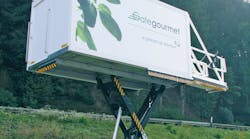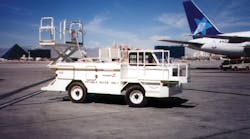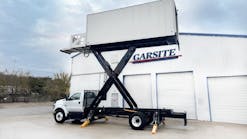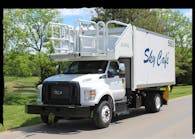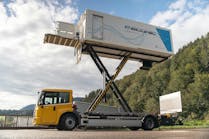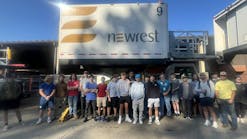People can’t walk five steps without hydrating themselves with some bottled water. We pay exorbitant prices for water thawed from glaciers or that has bubbled up from the deep. Or so it says on the label. Much of it is just plain tap water, which is – at least I hope – filtered and treated before bottling.
Every catering truck has flats and boxes of bottled water to be loaded on each flight. We did not, however, always carry this much. I remember when it was only the international airlines that carried Evian water and the like – and only then for their first-class passengers. Back in steerage or on the domestic airlines, everyone just made do with a tap adjacent to the galley or the lavs with a paper cup dispenser.
SIMPLE ENOUGH
Water systems on aircraft were sort of an afterthought. But it seemed simple enough to put a tank in the overhead and run some lines down to feed the faucets. Simple enough – until it gets complicated.
First, we have to fill the tank and that means a fill line and fill valve somewhere on the outside. Easy, right? Then again, airplanes fly to places where travelers are warned to never drink the tap water. So those same travelers might also be skeptical of what is put into the tanks at these remote locations.
On that note, water carts and water trucks are sometimes neglected. There are procedures for disinfecting them that need to be followed. The servicing stations that fill the trucks are not supposed to be the garden hose fill variety. Domestically, I believe the EPA has made some regulations in this area, with good cause. It takes some management initiative to drive home the idea that sanitary is as sanitary does. Clean equipment, clean hands and making sure the fill hose end is protected and the covers kept on the tank will prevent some expensive lawsuits filed by sick passengers.
MORE COMPLICATIONS
So now we have to service the system and make sure the water remains free of contaminants. More complications.
One airplane model I worked back in the 1950s that sported triple fins had its water tank located inside the sidewall of the aft baggage compartment. It was fitted with an electric pump to pressurize the tank – high-tech indeed. Lockheed had thoughtfully provided an access panel in the fuselage skin through which you could change the pump. Of course, the door was sized so the pump only fit through the hole at one precise angle, which took some time to discover.
What was more interesting was the algae growth I found when I pulled it out. It would have done an aquarium proud. I found no fish in the tank though. We disinfected the system, but the representative for the South American carrier who owned the aircraft thought we were just running up his bill.
Disinfecting and flushing this water system was no joy. It meant repeatedly filling a tow-around, 100-gallon cart. Since the cart was only fitted with a hand-operated diaphragm pump I spent a lot of effort pumping the water into the tank. Fortunately, it was only going into the belly tank, not up to the ceiling of the aircraft like some other models. Those took some real effort to service.
After disinfecting with chlorine bleach we used in those days, I filled and drained the system three times getting an interesting run of things out of the system. The coffee probably tasted different on the next flight
So if we’re going to be disinfecting and flushing, the tank best have a drain line, too. Besides, aircraft also spend a lot of time sitting around waiting – and airports tend to be among the coldest spots on earth. So draining was a must for overnighting in cold climates.
Our simple idea just became really complicated.
SERIOUS PROBLEM
Not draining an aircraft in freezing weather where it cannot be kept heated overnight can have serious consequences. I was called over to LaGuardia to debrief a captain who had made an emergency return due to jammed flight controls. He also had difficulty in lowering his landing gear to boot.
He was rightfully irritated after I brought him out to the aircraft and showed him the cause. A water line under the mid-cabin floor froze during the night and split. There was no evidence of leakage because the line was frozen.
In the morning the APU was cranked and the cabin-heated air began to circulate under the floor. After takeoff, the line thawed and leaked. The water pooled on top of the pressure bulkhead that formed the top of the main gear wheel well. It then, under cabin pressurization, drained through the seals around control cables leading into the wheel well. The water quickly froze around the cables and aileron/spoiler mixer mechanisms and, for good measure, the landing gear control valve.
The captain said he had detected jamming and had to use considerable force. Fortunately, he kept the ailerons moving; ice an inch-thick eventually coated the cables and the mechanism. Not a good thing at all and made for some old-fashioned strong arm piloting to move the controls. The gear was finally lowered by repeatedly jamming the landing gear control handle up and down. Good piloting and luck prevented a more serious incident.
On investigation, I found a ground heater had heated the airplane all night, but the heated air did not circulate under the floor as it does in flight. We ended up installing heater wires inside critical water lines that required running an extension cord from the loading bridge to the aircraft. Nice if you were parked at one; not so good if it was on a hardstand. We bought a lot of extension cords, they regularly got run over by servicing vehicles to their detriment. Overall, it must have worked as I never heard of another incident.
AN INTERESTING THING
One interesting thing is that water did not always flow downhill on aircraft that used gravity feed systems. It used to amaze me that water would not flow from a tank located six feet above in the ceiling that should have flowed down to the faucet in the lavatory. It defied Newton but usually was caused by airlocks in the system. Pressure systems are not immune to this either. After an overnight in freezing weather where the system was completely drained it takes a bit of knowledge to put all the valving under the sinks and in the galleys back to the operating position.
There is another reason for no water to flow. My company sent me to the Paris Air one year and allowed me to take my wife. The cargo airline I was working for by then had bought a lot of maintenance from Pan American for our B747 freighters. We got passes from them to fly New York to Paris.
Pan Am was unfortunately in its final death spirals. The aircraft scheduled for our flight went unserviceable, but not to worry. They would combine flights, and because of our priority we got the last two seats. They had to quick turn the B747, which was evident due to the lack of cabin cleaning. We sat in the last row on the port side; a double seat. I recommend everyone try it once. The view on takeoff is exhilarating when the aircraft rotates. You suddenly realize you are only a few feet above the runway rushing by. I now realize why there are tail strikes on takeoff as there is not much room for error.
Being in back put us next to the galleys and, of course, the lavs but I could not complain – we were going to Paris! Reluctantly, the service started and I was resigned to no choice of meals for the service started forward in our cabin. It was going to be the chicken. They were halfway back when I heard the flight attendant in the galley being verbally unhappy.
It seemed the water had run out. During the quick turn, they had neglected to service it. Want to hear pax complaints? Go on a long, fully loaded flight and have the water run out two hours after departure. No coffee, no tea, no hot towels, no washing your hands in the lavs. The bottled stuff ran out quickly as did the wet wipes. The loud complaints did not.
ABOUT THE AUTHOR: Tony Vasco worked for 54 years in maintenance. He earned his A&P at the Academy of Aeronautics in 1954 and held his first job at Lockheed Air Service at JFK. He then worked 22 years at Eastern working up to maintenance director. He held other high-level maintenance positions before taking his last job at Tradewinds Airlines as director of quality control.
